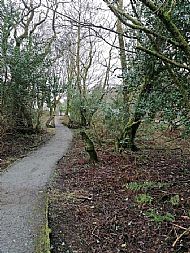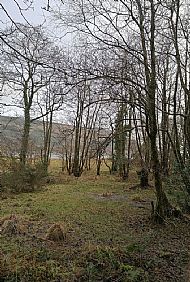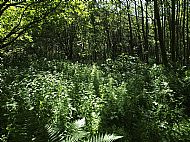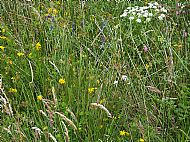Habitats
A number of distinct habitats exist in the reserve, and each has its own unique biodiversity.
A number of distinct habitats exist in the reserve, and each has its own unique biodiversity.





Maturing woodland
There are a few maturing Quercus robur (Pedunculate Oak), Fraxinus excelsior (Common Ash) and Acer pseudoplatanus (Sycamore) in three discreet zones.
Bog
Natural blockage of one of the drainage ditches through the woodland has resulted in the formation of a small area of permanently wet bog with predictable flora including Mentha aquatica (Water Mint), Caltha palustris (Marsh Marigold) and Epilobium palustre (Marsh Willowherb).
Pioneer woodland
This, the largest area of woodland, could be considered a brownfield site having previously been used for waste disposal. The tree flora is pioneer, specifically Salix capraea (Goat Willow), Betula pubescens (Downy Birch) and Alder, the latter being more associated with areas of poorer drainage with permanent surface water throughout the winter. The latter supports Lemna minor (Duckweed), Ranunculus flammula (Lesser Spearwort) and Equisetum fluviatile (Water Horsetail). Tree age estimates suggest that, over time, waste disposal activities have retreated back towards the only remaining small area of council yard (Fig. 1; CY). Thus, the youngest trees are nearest the existing site. Where there are gaps in the canopy, a dense under-story forms annually, comprised mainly of Rubus idaeus (Raspberry), Urtica dioica (Nettle), Digitalis purpurea (Foxglove) and Stachys sylvatica (Hedge Woundwort).
There is some evidence of succession, with decline of the largest Goat Willow and appearance of seedlings of Sycamore, Ash and Oak. Succession is complicated by the presence of Ash Die-back, caused by Hymenoscyphus fraxineus, amongst most of the naturally-sown seedlings. There has been some acorn germination, but subsequent seedling growth has been limited by deer grazing.
Management now involves removal of diseased seedlings of Ash in favour of symptomless, apparently-resistant trees, and use of tree guards around Jay (Garrulus glandarius)-sown (assumed) germinating acorns. Given the large number of tree species-specific, dependent animal and fungal species, other woody species that have not arrived by natural means, will be introduced in limited numbers in areas cleared of exotic conifers to promote biodiversity. These include Populus tremula (Aspen), Prunus padus (Bird Cherry), Prunus avium (Wild Cherry) and Cornus sanguinea (Dogwood). This area is never subjected to salt-water inundation, and several large alien conifer species have been recently felled.
Freshwater courses
Freshwater flows, year-long, through the drainage ditches that intersect the maturing woodland, and another permanent burn runs along two sides of the pioneer woodland. Significant interaction of these burns with seawater only occurs during the highest tides, creating brackish conditions. Winter run-off into these will include some road salt during cold weather. The deep wet shade supports bryophytes such as Mnium hornum and, in better-lit water, an unidentified Callitriche sp.(Water Starwort).
There are two much larger, permanent water courses draining pasture land to the North-west, and crossing the reserve saltmarsh to the sea. All but the lowest high tides inundate these with seawater, creating brackish conditions. Within these, the bottom consists of gravel in areas of high water flow and muddy, soft silt in areas of slower water flow.
Sea bed
The sea bed comprises rocky materials graded from gravel to fine sand with no boulders or rocks. There are also areas of deep silt, particularly where water speed is diminished around the two freshwater courses. The seabed is mainly colonised by Zostera noltei (Dwarf Eel-grass) and various species of brown algae.
Gravel ridges
Much of the seaward side of the head of the loch comprises shingle, gravel and shell ridges piled up by high winter tides. However, the various fresh-water courses draining into the loch prevent formation of a complete barrier. Furthermore, there is evidence of dynamism in both the position and extent of this shingle (Fig. 2 ) whose fate is determined by the arrival of plants whose roots bind it together, height and ferocity of high winter tides and winds, and rabbits digging into their edges.
High winter tides also deposit varying amounts of driftwood, seaweed, leaves and other vegetation onto these ridges. Action of sea and gravel grinds much of this washed-up vegetation into a more uniform, finer material akin to the types of material used by gardeners as mulch. This material adds to the height (and presumably fertility) of the ridges via the formation of soil.
Floristically, the gravel ridges are species-rich (Fig. 3), and most are protected from strong north-westerly winds by trees in leaf. Presumably, seeds of many plants have floated in on the sea. Species include Heracleum sphondylium (Hogweed), Stachys palustris (Marsh Woundwort) and Senecio jacobaea (Common Ragwort). This gravel is the only location at the head of the loch for Sagina procumbens (Pearlwort), Honkenya peploides (Sea Sandwort) and Trifolium pratense (Red Clover).
Gravel beach
A gradation of shingle height on the seaward side of the ridges gives rise to a beach community of salt-tolerant plant species growing directly in the beach (Fig. 4 ). These include Tripleurospermum maritimum (Sea Mayweed), Potentilla anserina (Silverweed), Atriplex prostrata (Hastate Orache), Silene uniflora (Sea Campion) and Rumex crispus (Curled Dock). The perennial species successfully withstand incredible battering and damage by winter storms.
Tidal islands A, B, C, D
Some areas of piled-up gravel are now sufficiently stabilised by vegetation, and elevated above sea level, to be islands even at the highest winter tides. Although there is no record of this, it is likely that the mixed broadleaved trees growing on all four islands, and in a dead-straight line on island C, were deliberately planted by people around 40 years ago. Island C woodland is sufficiently mature to allow woodland herb species such as Bluebells and Oxalis acetosa (Wood Sorrel) to be well established.
The remnant seawall itself is also an island at high tide, and is the main area on the reserve for Sambucus nigra (Elder) with its typical epiphytic bryophytes and lichens, and Sarothamnus scoparius (Broom).
Salt-marsh, sea, wind and organic deposits
Inundation of the reserve by the sea is greatest in winter. The gravel ridges protect the salt-marsh from the eroding effects of the worst winter conditions, creating some important, stable habitats. The highest tides do, however, still inundate the majority of the reserve via gentler incursion behind these ridges.
The extent of this can be assessed by deposits of externally-derived seaweed, dead leaves and a wide range of plastic objects. The distribution of both is affected both by the gravel banks, wind direction and the remnant seawall separating the ungrazed salt-marsh from pasture behind. The vast majority of seaweed accumulates in front of the seawall in the western part of the reserve (Fig. 5). Lesser amounts accumulate on top of the gravel ridges. Because of the surrounding hills, the most influential winds affecting the location of such depositions are those with an easterly element. It is likely that all of the saltmarsh habitats will have incorporated plastic items into their soils over the last few decades. During rough seas, some of this is exposed and released.
The highest tides and weather also erode dead plant material from the land areas of the salt-marsh. These are lifted by the tide, and winds accumulate this in similar areas to the seaweed and plastic deposits already mentioned.
Winter weather
During sub-zero temperatures, large amounts of ice form at the reserve, especially on the salt-marsh where high tides cause freshwater heading towards the sea to back-up and freeze onto the marsh in a layer above the salty water. Thus, shelves of ice are visible at low tides in these conditions.
Pioneer salt-marsh
There is almost no typical structural pioneer salt-marsh (Scottish Natural Heritage, 2016) at the reserve. Pioneer salt-marsh plant species including Puccinella maritima (Common Saltmarsh-grass), Salicornia europaea (Glasswort; Fig. 6), Suadea maritima (Seablite) and Spergularia spp. are largely confined to the lowest gravel spits, salt-pans and areas of beaches, all of which are free of significant tidal inundations throughout the Spring and Summer.
Given the broken sea wall, tides do inundate the fields behind the reserve, and these sheep-grazed areas are dominated by Common Saltmarsh-grass and Lysimachia maritima (Sea Milkwort). These areas are more typical of much of Scotland’s grazed lower-level salt-marshes (Fig. 7).
“Upper” salt-marsh
The areas adjacent to freshwater courses that drain through the marsh are lined with areas of flat mud dominated almost entirely by Juncus gerardii and some Agrostis stolonifera (Creeping Bent), with typical scatterings of Tripolium pannonicum (Sea Aster). These areas are regularly inundated even in Summer. In areas most exposed to winter seas, this part of the reserve is rapidly eroding (Fig. 8).
Meadow
Alongside, and between, the water courses, there is an obvious 40cm, or so, step up from upper marsh to “meadow”, with a different community of plants which are only inundated by the highest tides. Dominant plants include Ulex europeaus (Gorse) and Rubus fruticosa (Blackberry/Bramble), Festuca rubra (Red Fescue) and Creeping Bent.
A distinct area of this meadow level could be described as being dominated by dense stands of vigorous, so-called “rank” grasses such as Holcus lanatus (Yorkshire Fog), Elytrigia atherica (Sea Couch), Deschampsia caespitosa (Tussock Grass) and Arrhenanthemum elatius (False Oat Grass). These larger grass species may thrive here because these areas are least affected by high tides, but also because they coincide with areas subject to the large deposits of seaweed and other organic debris already mentioned (Fig. 5). Just as shoots of these large, vigorous perennial grasses emerge in Spring, the piles of dead plant material dry out rapidly, and become incorporated into the marsh, and disappear from view as the plants grow up through it. Angelica arvensis (Wild Angelica) also seems to favour this area, providing flowers in late Summer.
Throughout the higher areas of the marsh, away from these stands of rank grasses, carpets of primarily Creeping Bent and Red Fescue are interspersed by flowering angiosperms typical of so-called man-made “wild-flower meadows”. Early-flowering species include Lychnis flos-cuculi (Ragged Robin) and Ranunculus media (Meadow Buttercup), mid-season flowers include those of Lycopus europaeus (Gyspywort), Sonchus arvensis (Perennial Sow Thistle) and Carum verticillatum (Whorled Caraway: Fig.9), while Jasione montana (Sheep’s-bit Scabious) and Leontodon autumnalis (Autumn Hawkbit) are still flowering in late October. Given the importance of conserving pollinating insect species, the management plan includes increasing the balance of non-grasses to grasses in the meadows, especially in the large areas dominated by rank grasses.
Pools
As is typical of all salt-marshes, there are still many pools and underground channels on the marsh, especially on tidal island A (Fig. 1). Many elsewhere, however, have filled-up and disappeared. Ruppia maritima (Spiral Tasselweed) is dominant in many pools, while others have species of Callitriche and Juncaceae. Only one, mostly freshwater, pool appears to have an obvious population of animals and plants living in and on it (Fig. 10), and I aim to restore its size by digging as typical successional infilling is at an advanced stage..
Reed bed
In one area of the reserve, alongside a permanent burn, Phragmites australis (Reed; Fig. 1; RB) is becoming established into a small bed alongside solid blocks of Oenanthe crocata (Hemlock Water-dropwort). The value of controlling growth of this vigorous, shading umbellifer by scything to promote reed spread, will be evaluated in future. Calystegium sepium (Bindweed) is only found on the reserve climbing these reeds, and almost certainly affects reed productivity and spread (Fig. 11).
